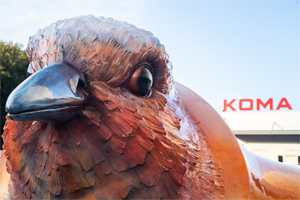
KOMA opened a pavilion originally made for the Expo on its premises
 |
"We had to transition from the hot days in Milan, where it was exposed over the summer; we had to prepare the entire building for the fact that it would be here for years, decades, and we had to prepare it for the harsh Wallachian winters. So we insulated it, added various technologies, it is an energy-efficient building," Martinec stated.
The interior space of the building has an industrial feel. "There is no drywall here, there is iron, wood, glass, typical industrial elements. It is a tribute to Tomáš Baťa, so he might have seen his offices this way if he were alive," Martinec noted. The interior space is open to the roof, with an art piece running from the first floor to the ceiling—a spiral canvas with colorful motifs created by Barbora Šlapetová, which contrasts with the industrial environment. It symbolically represents the story of KOMA. In front of the building and on its roof are sculptures of birds by Lukáš Rittstein.
The ground floor of the building is open to the public, currently hosting an exhibition about the Czech Republic's participation in Expo exhibitions, with office spaces on two floors. There is seating and an herb garden on the roof with views of the company's area, nature, and Vizovice. Next year, a modular development center is expected to be added to the area.
The return of the pavilion to Vizovice, along with all related work and modifications, cost the company over 100 million crowns. Just the demolition of the original buildings in the area and the land modifications with the construction of foundations cost 40 million crowns. The reconstruction of the building cost 70 million crowns. "We have 42 modules from Expo, the lower structure, an elevator, half of the slats are from Expo, and half are new," Martinec explained.
The company, employing about 250 people, according to the director, after years of heavily producing modules mainly for refugee accommodation, is now working on more demanding projects. "We are currently working on a hotel for Paris, a cultural center, and a kindergarten. These are quite challenging projects, technically more demanding," said the director, who plans to create a Koma village in the valley opposite the company area, where architects would design modular houses.
The English translation is powered by AI tool. Switch to Czech to view the original text source.
0 comments
add comment
Related articles
0
01.03.2019 | The most attractive work environment is in Vizovice
0
20.11.2018 | Z EXPA back to Vizovice or KOMA MODULAR has a new headquarters
0
16.10.2017 | Vizovická KOMA will utilize the pavilion that it produced for the Expo within the complex
0
30.10.2015 | <div>Czech pavilion won a bronze medal for architecture at Expo 2015</div>
0
16.05.2015 | The Czech pavilion at the Expo will most likely move to Vizovice after it ends
0
13.08.2014 | <Czech>Česko začalo stavět pavilon pro výstavu Expo 2015 v Miláně</Czech><English>Czech Republic has started building a pavilion for the Expo 2015 exhibition in Milan</English>
14
13.12.2013 | The pavilion for Expo 2015 will be built by the company KOMA













